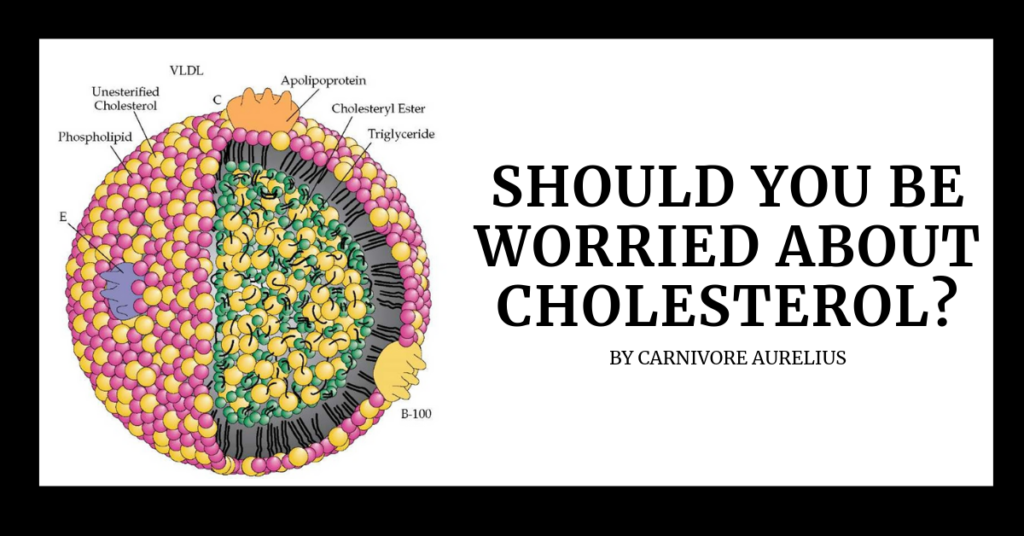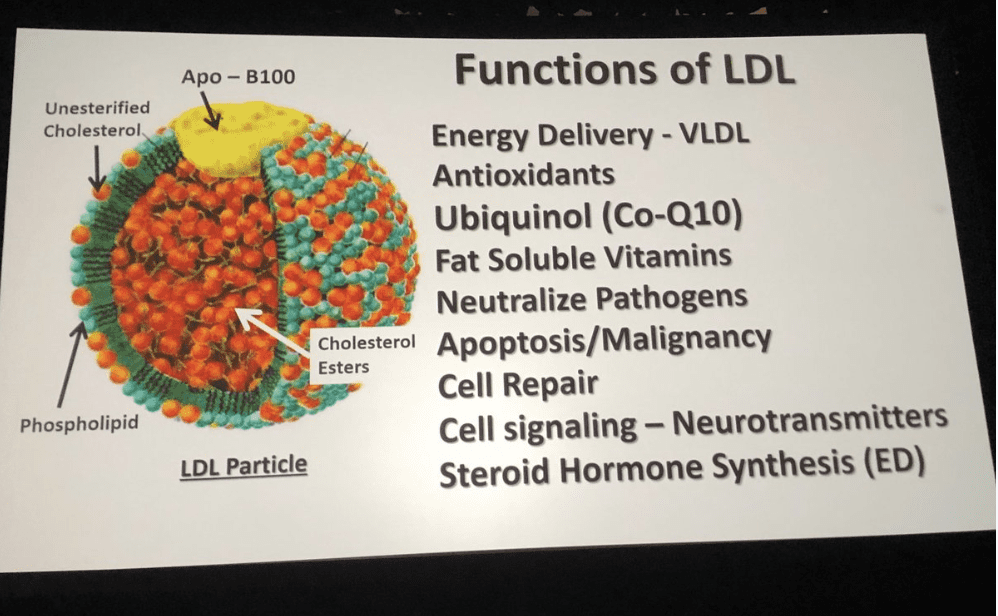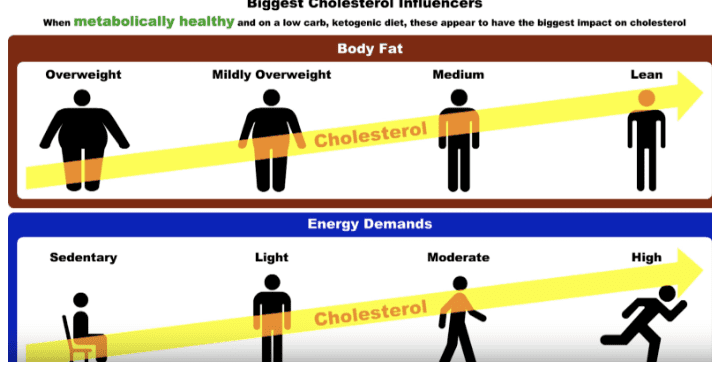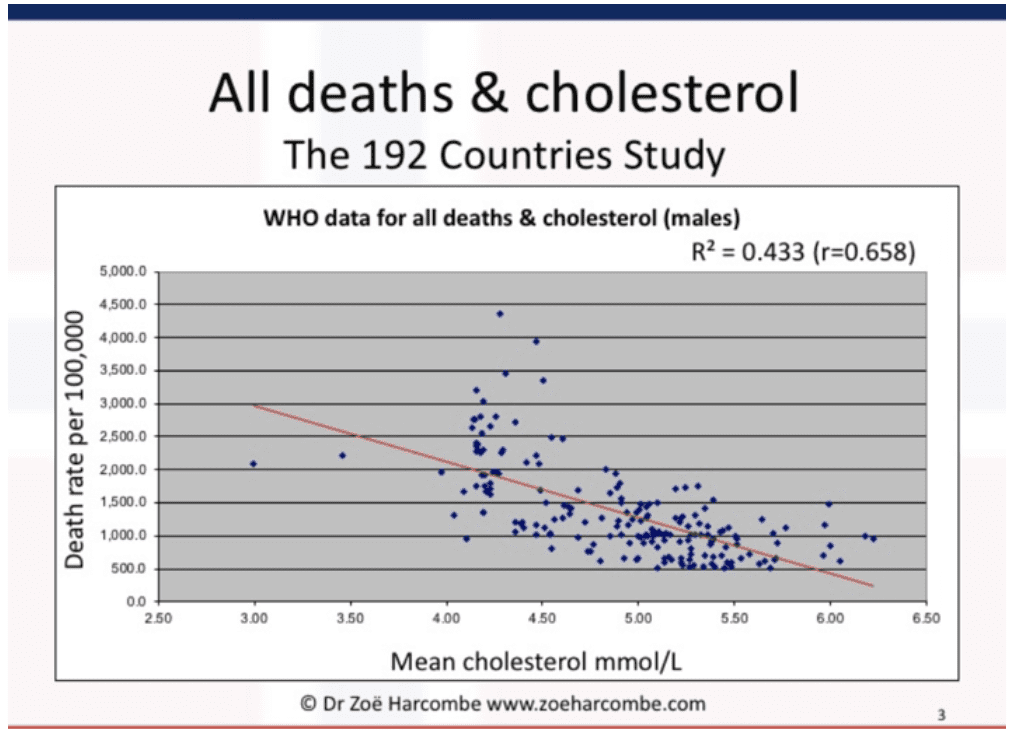Cholesterol tends to spike on a carnivore diet. Should you be worried?

It’s permanently etched in most people’s brains that meat will spike cholesterol and cause heart disease.
Since the 1950s, cholesterol, like saturated fat, has been feared.
The first Google search for “steak and cholesterol” suggests we avoid steak because it raises cholesterol.

How did this happen? And should you really be worried?
How Did We Get Here?
Why did cholesterol get put into the penalty box? Three main studies damned cholesterol:
1) 1913 Russian study on rabbits showed that cholesterol caused lesions. But rabbits are herbivores
2) Ancel Keys and his CORRUPT seven countries study showing a correlation b/w saturated fat & heart disease
3) A study in Framingham, MA 60 years ago claimed cholesterol led to heart disease [*].
All three ultimately led to the diet-heart hypothesis and Food Pyramid.
Cholesterol was the critical second link of the diet-heart hypothesis. Ancel Keys came to the conclusion that heart disease tended to be related to cholesterol. And saturated fat tended to increase cholesterol. Therefore saturated fat and cholesterol caused heart disease.
After cholesterol was found to be present in artery walls in patients with heart disease, cholesterol was blamed as the cause of the disease.
But we convicted the wrong enemy.
Cholesterol was present in all heart disease patients because it was there to rescue their artery walls.
It’s like condemning firefighters for starting fires just because they’re present at all fires. The logic is completely backwards.
What matters is how the fire started in the first place.
What is Cholesterol? We Can’t Survive Without It
Cholesterol is an organic molecule found in cell membranes and most tissues. It’s in the food we eat and is naturally occurring within our bodies.
Of the cholesterol present, around 75% is created in our bodies, and 25% is ingested.
Cholesterol is one of the most vital compounds in our bodies. So vital that our bodies make around 3000 mg of it every single day. [*] We can’t leave it to chance to get it externally – it’s that important.
Without cholesterol, we would literally be dead.
Cells would disintegrate. We’d have no hormones, no brain function, and no muscles. Every cell membrane is constructed out of cholesterol.
All of the following critical body components are made from cholesterol: [*][*]
- Estrogen
- Testosterone
- Cortisol (anti-inflammatory stress hormone)
- Aldosterone (regulates salt balance)
- Vitamin D
- Bile (required for fat and vitamin absorption)
- Brain synapses (neurotransmitter exchange)
- Myelin sheath (insulates nerve cells)
Not having any cholesterol is MUCH worse than having too much of it.

Studies Confirm Total Cholesterol Is Not an Issue
In 1987, a thirty year follow up to the Framingham study was conducted — the study that crucified total cholesterol in the first place.
Those aged between 48 and 57 with cholesterol in the mid range (183-222 mg/dL) had a greater risk of heart attack than those with higher cholesterol.
They also found that “for each 1 mg/dL per year drop in serum cholesterol values, there is an 11% increase in both the overall death rate and the CVD death rate.” [*]
Talk about shooting yourself in the foot. Not only was total cholesterol not predictive, it actually had a negative correlation. Low cholesterol increased risk.
The last supporting thread of Keys’ diet-heart hypothesis should have been broken.
But not so fast…
Scientists Shift Focus to Good and Bad Cholesterol
We’ve had a breakthrough in lipidology in recent years, and nutritionists have shifted their focus from total cholesterol to its constituent parts.
You’ve probably heard of LDL and HDL – often referred to by doctors as “good” and “bad” cholesterol. LDL was dubbed “bad” and HDL has been dubbed “good” because of a number of associational studies (i.e. studies closer to astrology than real science.)
In 1984 it was deemed an “irrefutable fact” that LDL (LDL-C for those following along) causes heart disease.
Michael Brown and Joseph L. Goldstein, who won a Nobel Prize for their work, cemented this “fact”, declaring that the research “demonstrates unequivocally the causal relation between an elevated circulating LDL and atherosclerosis” [*].
Instead of focusing on total cholesterol, Brown and Goldstein convinced the medical establishment that LDL was the real cause of heart disease.
Maybe the third time was the charm?
Epidemiological studies around this same time also showed that low HDL levels were associated with higher heart disease risk [*], which forced some to acknowledge that maybe cholesterol wasn’t completely a villain after all.
But the segmentation into “good and bad” cholesterol is inaccurate. HDL and LDL both play important roles. Neither LDL or HDL are inherently good or bad.
Dr. Peter Attia puts it best:
“What’s bad is when good cholesterol ends up in places it’s not supposed to be.” [*]
Or said another way, good cholesterol becomes “bad” when it gets damaged by bad foods.
What are HDL and LDL Anyway?
Part of the confusion stems from what LDL and HDL actually are.
LDL and HDL aren’t even cholesterol, but energy transport vehicles that are partially composed of cholesterol [*].
A fat molecule repels water, and thus cannot travel through our largely water-based blood on its own. Cholesterol, along with other proteins, forms a floatie for fat to cling onto.
These floaties are called lipoproteins. Think of them like cars that each fat molecule and nutrient can use to get to cells. All in all, they make up what is often referred to as the lipid transport system.

The ratio of lipid-to-protein determines its density. HDL is the most dense. And VLDL the least.
Despite the mixed results of studies, LDL has become the target of doctors who rush to prescribe drugs if LDL is over 190 mg/dL.
Today, LDL, the notoriously “bad” cholesterol, is the target of the MASSIVE cholesterol suppressing statin industry. Lipitor has made Pfizer $125bn since 1997 [*].
This is a huge part of the reason why the world has been so slow to shift. $125bn is on the line. Of course they don’t want change. Sorry Pfizer.
But merely evaluating LDL levels distracts from the real story of what is biochemically occuring behind the scenes.
The Cholesterol Response To A High Fat Diet
This brings us to the carnivore diet.
Like many nutritionists fear, people on the high-fat ketogenic diet often see their LDL cholesterol and total cholesterol rise.
Should you be concerned that the supposedly bad cholesterol is rising? What does the rising cholesterol really mean?
Why Cholesterol Tends to Rise on a High Fat Diet
The Lipid Transport System
Dave Feldman has done a remarkable job breaking down the lipid energy transport system and cholesterol’s + lipoprotein’s crucial role.
Going back to the car analogy, LDL is like a car, and the passengers are like the fat and nutrients.
LDL-P, in this case, are vessels that take fat (energy) to cells.
HDL are the clean up crew. Sort of like draino for your blood vessels.
High LDL levels is similar to having lots of cars on the street making lots of deliveries. Not necessarily a problem, and evident of a thriving ecosystem.
One reason why LDL tends to rise for healthy, active, low-carb-high-fat dieters is because more cars are simply needed to make more deliveries.
Your body is both secreting and using more fat as energy. [*]
Remember: you either use fat or carbohydrates for energy. When you cut out carbohydrates, you need to deliver fat to your cells to survive.
Think of it like a cab during New Year’s Eve.
A lot of cabs are around, because there are more customers to use them. This doesn’t mean that the city is broken – it just means that more people need to get around.
In fact, as many of you have experienced, Dave Feldman also found that when metabolically healthy people switch to low carb, their cholesterol levels tend to rise.
As you can see below from Dave Feldman, an improvement in body fat and metabolic health, actually led to an increase in cholesterol.

What’s happening is that your body is secreting and using more of these LDL delivery boats.
Because you’re metabolically healthy and not eating carbohydrates, your body needs to mobilize more fat as energy. And this is a big reason why these people are getting leaner. They should be celebrating their higher LDL numbers because it means they’re actually burning body fat for energy unlike their carb-ridden counterparts.
LDL and HDL Aren’t Inherently Good or Bad
It’s a massive oversimplification to say that LDL is harmful because it puts cholesterol into the cell walls and thus should be feared.
High LDL alone is not “bad”. Nor is high HDL “good”.
Why would our bodies make any particles that inherently cause heart disease? If the particles were inherently bad, we should remove our brains because they’re signaling to make 3000mg+ a day.
The particles on their own don’t cause heart disease.
As Dave Feldman says, what causes plaques in arteries is not the particles themselves, but a broken energy delivery system.
This isn’t to say you shouldn’t be concerned about high LDL levels. Technically, in Peter Attia’s terms, heart disease occurs when LDL-P gets into your arteries, becomes inflamed, and plaques up [*].
But this doesn’t mean that LDL independently causes it.
Studies Confirm LDL Alone Is Not an Issue
In fact, there are zero studies that show that high LDL is a risk factor, independent of triglyceride levels and HDL levels. [*]
What matters is the functioning of your lipid and energy transport system.
And a big reason why there is often a correlation between LDL, HDL and heart disease is because they are potentially indicative of a broken system.
And you know what? New scientific research confirms this.
There’s not a single randomized control trial that shows people with high LDL die younger. David Diamond has done some great work here.
In fact, some studies show that higher LDL-C is associated with equal or greater lifespan [*].

When it comes to total cholesterol, a study in Hawaii found the same. Having low cholesterol for a long time actually increases risk of death:

Instead of continuing to dig their heels in, I do appreciate the honesty of the study above: “we have been unable to explain our results”.
Whoops.
This study from UCLA showed that 75% heart disease patients had LDL below 130 mg/dl — the level at which doctors prescribe statins.

The above data shows that saturated fat can raise cholesterol. But no evidence has shown that, independent of other factors, high cholesterol is a cause for concern.
Lastly, remember the seven countries study that blamed saturated fat and cholesterol for heart disease? Well Zoe Harcombe added in 290 more countries and the correlation flipped. Cholesterol actually becomes negatively correlated with heart disease.

It’s time to stop worrying about LDL, the “bad cholesterol”.
So What Really Causes Heart Disease?
As we’ve seen, high LDL levels on their own don’t cause heart disease. They’re not shooting into your artery walls for no reason. This is why LDL independently is not a good predictor for heart disease.
Our bodies have been producing LDL cholesterol forever. But heart disease really only appeared in the last 100 years. It can’t be the LDL independently causing issues.
With that being said, it doesn’t mean you should ignore LDL levels, Because high LDL can be indicative of a broken system. It’s seen in both high and low risk patients.
And a broken system is what causes heart disease.
Atherosclerosis is the disease caused by this lipid delivery cycle being broken. It’s when plaques start forming in your arteries.
When the cycle is broken, LDL cholesterol is usually high. But this doesn’t necessarily mean that high LDL is the sole cause.
Let me explain with the analogy.
What’s bad is not if there are a lot of cabs around. It’s bad if the passengers – the energy – aren’t getting delivered to the proper places. Or if the vehicles themselves are damaged (oxidized), yet still driving.
When this happens, there is an underlying problem. Your immune system reacts and causes inflammation, which leads to plaquing.
Damaged LDL is The Problem
There’s no such thing as “good and bad” cholesterol. What’s bad is when your cholesterol gets damaged (or oxidized). When it’s damaged, your immune system traps the damaged cholesterol in your artery walls to prevent it from doing even more damage elsewhere.

How do you damage your cholesterol particles? Sugar and vegetable oils. Two of the first things you cut out on the carnivore diet.
Sugar does a couple of things to your cholesterol particles that cause problems:
- Sugar tends to stick to your LDL lipoproteins, causing them to lose their motor functionality. [*] This is often referred to as oxidation or glycation.
- Sugar damages HDL, causing it to be rapidly cleared from the blood. [*]
- Triglycerides cannot be delivered to the cell because the fat cells are already full because of sugar, and are likely insulin resistant.
Vegetable oils do something similar. LDL is more prone to oxidation when it contains unstable linoleic acid from seed oils. LA is the most common fatty acid from LDL.
Once LDL is oxidized, LDL receptors no longer recognize it. Instead, the immune system takes over. When LDL is oxidized your body actually intentionally pulls it into your artery walls to prevent them from causing damage elsewhere [*]
These damaged lipoproteins will then cause an inflammatory response, foam cells and plaquing. Macrophages basically ingest the modified LDL and turn into foam cells. Over time, multiple of these foam cells form fatty streaks together.
If this damage continues long enough, muscle cells are attracted to the area to health the foam cells. This good faith attempt by the immune system ends up becoming atherosclerotic plaque.

Well, on the carnivore diet, you tend to have big fluffy and healthy cholesterol. It’s only when you damage LDL particles with sugar and vegetable oils, do they cause issues.
LDL Also Increases Because of Inflammation
Another reason LDL is often high when people have heart disease is because it’s indicative of an inflammatory environment.
LDL plays an indispensable protective role. There’s a reason why we produce it. LDL is protecting you from disease, not causing it.

Because of its protective role, LDL actually increases when there’s inflammation. LDL can bind to pathogens so that the immune system can expel them.
So, the reason it’s high in those with heart disease is because LDL binds to pathogens. It’s getting rid of damage so that it doesn’t spread.
LDL is protecting you from disease, not causing it.
Siobhan Huggins does a great job dissecting this process here.

What the mainstream thinks: LDL shoots into your artery and causes disease.
What really happens: LDL is recruited to heal inflammation and can be a sign of an atherogenic, inflammatory environment. It’s there to help, NOT cause disease.
Again, the causation here is backwards. LDL tends to be high in environments that are atherogenic. It’s not causing the inflammation.
It’s your crappy diet causing disease.
What BioMarkers Are Predictive of Heart Disease?
LDL, the “bad cholesterol”, is not predictive alone. Of course not. Because it is not inherently harmful. It’s only indicative of an atherogenic environment when it’s coupled with inflammation and oxidation.
What is the signature of inflammation and oxidation?
It usually rears its head as high TG / HDL ratios and high fasting insulin.
In a recent study of 103,446 men and women, LDL levels showed very minimal effect on heart disease.
But an increase in triglycerides/HDL ratio doubled the risk of heart disease. [*]

High triglyceride/HDL ratios are indicative of high remnant cholesterol, which is a better indicator for heart disease than LDL alone [*].
Dave Feldman showed below that remnant cholesterol correlated highly with all cause mortality.

And guess what is significantly associated with remnant cholesterol? Insulin resistance [*].
When it comes to biomarkers, I like to see:
– Total / HDL < 4
– TG / HDL < 1
– HDL > 40
– TG < 100
– Fasting insulin < 10
– Fasting glucose < 5 mmol/L
LDL, the “bad cholesterol”, is nowhere to be found…Why?
Big pharma can’t make money off the REAL predictive biomarkers
Make sure to also keep an eye on fasting insulin levels.
From the great Ivor Cummins: When insulin is low, high LDL particle count and high triglycerides don’t indicate that you’re at higher risk. [*]

But when insulin is high, the risk of high triglycerides and high LDL is magnified.
When fasting insulin is >15 uU/mL, your risk of heart disease with the same triglyceride levels go up 6.7x. And with the same LDL-P levels, it increases 11x.
High LDL with high insulin is much more concerning than high LDL with low insulin.
Carbohydrates Also Damage the Arterial Defense Layer
What else causes heart disease? A damaged endothelial layer.
Not only do carbohydrates lead to insulin resistance and high remnant cholesterol, they also damage your arterial defense system.
The image from Ivor Cummins below shows your glycocalyx, your first line of defense,before and after eating carbohydrates.

Carbohydrates destroy the arterial defenses.
How You Can Start Getting Healthier Now
All in all, heart disease is much more complicated than “high LDL” shooting into arteries. It’s a complex interplay between inflammation, lipoprotein health,and overall metabolism. Be wary of people who simplify this.
So how do you cut your heart disease risk? The three most important first steps are:
- Lowering inflammation
- Ensuring the health of your lipoproteins
- Increasing nutrient intake that heal blood vessels
The Carnivore diet is the best way to do so.
Lowering Inflammation
The carnivore diet switches your body to fat based metabolism which is less oxidatively stressful and has been shown to lower inflammation.
Glucose is oxidatively stressful, causes inflammation and can produce reactive oxygen species [*].
A study of 29 people found that those consuming just 40 grams of added sugar had an increase in inflammation, insulin resistance and weight gain [*].
The carnivore diet can also reverse leaky gut. Leaky gut increases inflammation because it allows foreign toxins into your bloodstream. Your immune system is mobilized to expel it, which creates inflammation. The carnivore diet cuts out antinutrients like Lectin and Gluten that pry the gut open. And it is also high in nutrients that reinforce the gut lining.
Lipoprotein Health
As discussed above, LDL is only bad when it is oxidized. It only becomes oxidized when your diet is high in polyunsatured seed oils and sugar.
Unlike natural saturated fats, these oils are unsaturated and have more double bonds. The double bonds allow oxygen to sneak in and oxidize the fatty acids, particularly when heated. When “oxidized” they produce free radicals. Free radicals are electrons that play a role in every known disease.
They are unpaired electrons looking to find a match. In the process of doing so, they restructure every single cell they come into contact with. Think of them like a drunk person in a singles bar.
Cooking foods in vegetable oils blasts them with these free radicals which can destroy every cell in your body. It’s these oxidized lipoproteins and free radicals that cause your immune system to trap them in your artery wall.
If you’re not convinced yet, here’s a revealing study.
The Sydney Heart Health study which was a randomized control trial that was supposed to support the AHA’s hypothesis ended up showing the disastrous consequences of vegetable oils. The group that replaced saturated fat with vegetable oils had a 62% higher death rate [*]. Of course this was buried.
Sugar also sticks to and glycates LDL. Glycation is the process by which glucose binds to a protein on the lipoprotein and damages the receptors your body uses to identify it [*].
Sugar and seed oils are the real enemy. NOT saturated fat, even though it increases your cholesterol.
Increased Nutrient Intake
The carnivore diet is very high in nutrients that heal your artery wall and lipoproteins.
One of the most risk factors for heart disease is artery wall calcification [*]. Vitamin K2 can reverse the calcification process.
Vitamin K2 has the ability to scavenge calcium that’s deposited in your arteries and shuttle it back to where it’s supposed to be — your bones. But most people are deficient in this critical vitamin.
One study showed that 360mcg of Vitamin K2 per day (taken as MKT) significantly improved artery health (reduced stiffness) [*].
Vitamin K2 is only found in animal source foods. You can get it in high doses in beef liver and fermented dairy products like cheese.
Additionally, the carnivore diet is high in antioxidants like Vitamin E, that can help lipoproteins resist oxidative damage. This study showed that Vitamin E significantly decreased LDL and HDL susceptibility to damage [*]. Vitamin E is only found in animal source foods.
Starting to notice a pattern here…The Standard American Diet both damages your arteries and is low in nutrients that can help to heal them.
Conclusion
You’ve been brainwashed into believing made up causes of heart disease:
– Steak
– Cholesterol
– Saturated Fat
But the real causes have nothing to do with these three. They are:
– Refined carbs
– Seed oils
– Oxidized LDL particles
– Inflammation damaging the glycocalyx
– High blood pressure
Too little cholesterol is WAY worse than too much. Lowering LDL too far is the fastest way to die.
Meat’s effect of raising cholesterol should be touted as a benefit, not a drawback.
We’ve talked about a lot here, and I really hope that you get a lot out of this article. It wasn’t easy for me to learn all this information – it took me years to learn about these things and improve my own health.
It’s time to take back control.
Source: https://carnivoreaurelius.com/cholesterol-on-carnivore-diet/